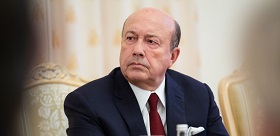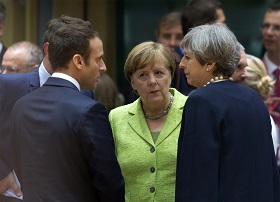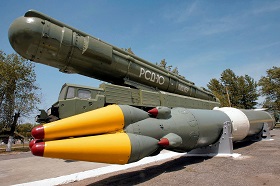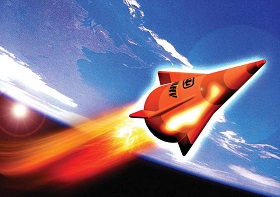Despite the attempts of Russian and U.S. sides to find common ground on the Intermediate-Range Nuclear Forces (INF) Treaty, it appears that the agreement will cease to exist this year. So what next?
Russia has been demonstrating a rather high degree of flexibility of late, including publicly, by stating its readiness to reveal its “controversial” 9M729 land-based cruise missile and then holding a presentation on it (even though the scale of the event was, apparently, smaller than the one that was originally proposed to the U.S. partners).
Unfortunately, the key NATO and EU member nations ignored the presentation, and not necessarily of their own volition [1]. The United States, for its part, continues to express concerns about the 9M729 cruise missile breaching the INF Treaty, demanding the destruction of both the missile and the associated launchers under Washington’s supervision.
On February 2, the United States will start the process of “suspending” its obligations regarding the INF Treaty. The Ministry of Foreign Affairs of the Russian Federation has already described the decision as being “legally void.” Washington, however, sees this as a way to develop missiles that would be otherwise prohibited by the Treaty.
The worst-case scenario would involve the rapid development and deployment by Russia and the United States of conventional and nuclear medium- and short-range missiles on both sides of the NATO–Russia border: in Russia’s Western Military District (including Kaliningrad exclave) and throughout Central and Eastern Europe.
It is much more likely that all the actors involved will exercise some degree of self-restraint. The interested parties could state their intentions to refrain from unprovoked deployments of missile systems. This would prevent any restrictions on R&D efforts, while at the same time facilitating a relatively stable strategic military architecture.
The possibility of some arrangements between European countries and Russia deserves special attention. Here, the key objective is to change the perception both in Moscow and in the European capitals: it is not about splitting the transatlantic unity or driving a wedge between Western and Eastern Europe. On the contrary, the emergence of a purely European arms control regime should help the disintegrating U.S.–Russia system of treaties remain in place. This, however, would require both parties to act fairly boldly.
Unless the United States resorts to overly provocative activities in terms of deploying new intermediate and shorter range missile systems aimed directly at the Russian strategic nuclear forces (SNF), then Russia will continue with the current pace and targets for the modernization of its SNF as permitted by the New START Treaty.
Russia and the United States managed, in previous decades, to reach a very high level in terms of sharing reliable information on their strategic nuclear forces, and it would be a real pity to see this potential go to waste. However, it is becoming increasingly obvious that these relations are very much unique. It is quite possible that we will return to a time when there were no legally binding restrictions on Russian and U.S. nuclear forces. This might be the point at which a new polycentric nuclear order will begin to form. To begin with, it would be advisable to develop a system of measures aimed at building confidence and transparency, as the existing asymmetry in the arsenals of the nuclear powers dooms any potential attempts to introduce universal or proportional constraints to failure.
Despite the attempts of Russian and U.S. sides to find common ground on the Intermediate-Range Nuclear Forces (INF) Treaty, it appears that the agreement will cease to exist this year. So what next?
Fighting for Opinions
Russia has been demonstrating a rather high degree of flexibility of late, including publicly, by stating its readiness to reveal its “controversial” 9M729 land-based cruise missile and then holding a presentation on it (even though the scale of the event was, apparently, smaller than the one that was originally proposed to the U.S. partners).
Despite the fairly simple diagrams of the 9M729 and 9M728 missiles displayed on their transport-and-launch containers and the launcher’s similarity to that of the "Club-M system that was first demonstrated back in 2007 as part of the setup for the land-based variant of the Kalibr missile (even though it was a shorter-range version intended for export), this information appears to be quite interesting. Furthermore, the data supplied by Russian sources largely confirms the assumption that the warhead is the main feature of this new cruise missile for the Iskander-M tactical missile system. At the same time, it is possible that the “new but not-so-new” launcher had been planned all along, but did not emerge until now due to concerns about possible breaches of the INF Treaty, and that it was only greenlighted once an appropriate, militarily significant cruise missile had emerged that met the INF requirements and required a new launcher type (other than the “classic” 9P78-1 one). It may very well be that the new launcher is not suitable for 9M723-series quasi-ballistic missiles, and there are questions about its compatibility with the accompanying transporter-loader vehicle; however, the missile’s increased accuracy and power (and possibly its enhanced capability to overcome enemy missile defences) was clearly considered to be very valuable.
Unfortunately, the key NATO and EU member nations ignored the presentation, and not necessarily of their own volition [2]. The United States, for its part, continues to express concerns about the 9M729 cruise missile breaching the INF Treaty, demanding the destruction of both the missile and the associated launchers under Washington’s supervision.
On February 2, the United States will start the process of “suspending” its obligations regarding the INF Treaty. The Ministry of Foreign Affairs of the Russian Federation has already described the decision as being “legally void.” Washington, however, sees this as a way to develop missiles that would be otherwise prohibited by the Treaty. It should be noted that the United States started planning research and development in this field several years back, and the first test launches may be expected in the near future. It could start with test-launching land-based versions of its air- or sea-launched cruise missiles, for example. Another possible pioneer might be a new tactical missile being developed as part of the Precision Strike Missile programme (formerly known as Long Range Precision Fires), which is to replace the good old ATACMS programme. Raytheon is a participant in the project with its DeepStrike project, whose advertised maximum range stands at the marvellously precise figure of 499 kilometres.
What Next after INF Treaty?
If the United States notifies Russia (and the other post-Soviet states) on February 2 about its withdrawal from the Treaty, how will the situation unfold over the next six months? [3]
The worst-case scenario would involve the rapid development and deployment by Russia and the United States of conventional and nuclear medium- and short-range missiles on both sides of the NATO–Russia border: in Russia’s Western Military District (including Kaliningrad exclave) and throughout Central and Eastern Europe. It would take at least a year for the respective missile units to become fully operational, but even announced plans on their deployment would ruin whatever is left of the European security architecture, including the Russia-NATO Founding Act. Western Europe is unlikely to support such processes; however, Eastern European countries may be willing to host U.S. offensive systems within the framework of bilateral agreements. This may indeed trigger a crisis in the West, including within NATO and the EU, but Russia is sure to suffer much more from such a return to the Missile Scares of the 80s. Moscow is much closer to NATO borders today than it was back then due to geography and political developments, and the the military threat emanating from the Alliance is playing a serious role in the way Moscow’ perceives this threat policy-wise. Russia will certainly need to take into account the drastic reduction in decision-making times should hostilities break out, which could result in pre-delegation of the authority to use nuclear weapons to lower levels of the command chain, or even in fully automating this process, given the heightened interest in the topic on the part of the country’s top political and military leadership. It is partially because of these risks that it would be a bad idea to rush to deploy new missile systems, thus poring fuel to the simmering conflicts.
It is much more likely that all the actors involved will exercise some degree of self-restraint. The interested parties could state their intentions to refrain from unprovoked deployments of missile systems. This would prevent any restrictions on R&D efforts, while at the same time facilitating a relatively stable strategic military architecture. Other possibilities include agreements that would restrict the geography of possible deployments – for example, Europe could be declared an area free from intermediate and shorter range missiles. However, such a decision would have a negative impact on the theoretical possibility of developing a global regime (not even a prohibitive regime, but just a restrictive or more transparent one) that would involve China, India, Pakistan, Iran, Israel and other actors.
In addition, if all the parties involved were prepared to withdraw from the INF Treaty, they could coordinate joint decisions on payloads for non-strategic missiles to be deployed. The Treaty does not distinguish between nuclear and conventional warheads, which is something worth revisiting in any eventuality [4]. Such a discussion would help the parties to return to the broader topic of control over tactical nuclear weapons, especially given the fairly interesting proposals that have emerged recently.
The possibility of some arrangements between European countries and Russia deserves special attention. Here, the key objective is to change the perception both in Moscow and in the European capitals: it is not about splitting the transatlantic unity or driving a wedge between Western and Eastern Europe. On the contrary, the emergence of a purely European arms control regime should help the disintegrating U.S.–Russia system of treaties remain in place. This, however, would require both parties to act fairly boldly.
The Future of New START and Arms Control
It should be stressed here that, unless the United States resorts to overly provocative activities in terms of deploying new intermediate and shorter range missile systems aimed directly at the Russian strategic nuclear forces (SNF), then Russia will continue with the current pace and targets for the modernization of its SNF as permitted by the New START Treaty.
In early 2019, the U.S. media ran a Russian letter to the United States Senate Committee on Foreign Relations. The document explained Russia’s position with regard to the allegations of the United States that Moscow had failed to observe the INF Treaty [5]. Without going into much detail as to the essence of the mutual accusations, it should be noted that Washington’s failure to embrace a constructive approach presents the key threat to prolonging New START beyond 2021. Most importantly, Russia is presumably prepared to agree to a system of so-called “cabinet-level written political commitments”. Those are possible with regard to the cap on the total number of ballistic missile launch tubes on U.S. Ohio-class submarines (with the exception of those intended to make up for the missile potential of any lost launchers). A similar principle could be applied to upgraded Tupolev Tu-22M3M long-range bombers, which can theoretically be retrofitted with in-flight refuelling capabilities (thus boosting their range beyond 8000 kilometres) and the ability to release air-launched cruise missiles with a range of over 600 kilometres. This would turn such aircraft into heavy bombers under New START. The aforementioned letter states that Russia has no such intentions with regard to this bombers, but a relevant formal written commitment might prove to be a useful instrument of trust and security. This aspect of arms control may yet come to the fore should Russia-U.S. relations deteriorate further, including under the influence of domestic political processes in the United States.
Russia and the United States managed, in previous decades, to reach a very high level in terms of sharing reliable information on their strategic nuclear forces, and it would be a real pity to see this potential go to waste. However, it is becoming increasingly obvious that these relations are very much unique. It is quite possible that we will return to a time when there were no legally binding restrictions on Russian and U.S. nuclear forces. This might be the point at which a new polycentric nuclear order will begin to form. To begin with, it would be advisable to develop a system of measures aimed at building confidence and transparency, as the existing asymmetry in the arsenals of the nuclear powers dooms any potential attempts to introduce universal or proportional constraints to failure. It is possible that the principle of “commitments” and other such solutions currently being discussed by Russia and the United States with regard to the controversial issues of New START could contribute to the foundation of such a “post-bipolar” regime. China, for one, might prove more willing to embrace a regime like that than a full-blown international treaty complete with stringent restrictions and mandatory inspections.
To conclude, let us revisit the founding principles: Why do countries need arms controls at all? Without getting bogged down in theoretical considerations, such controls resolve two problems: they mitigate risks by increasing the transparency and understandability of the doctrines and structure of the potential adversary’s armed forces, while optimizing one’s own military structure thanks to streamlining the range of defence programmes and curtailing the number of weapons and equipment in active service. It would appear that, today, the INF Treaty is failing to meet these goals, at least in the eyes of the U.S. administration. Whether or not this is because of Russia’s alleged breach of the Treaty or a perceived threat from third countries is of secondary importance.
1. It is noteworthy that, according to Kommersant, “following the [Russian] Foreign Ministry's news conference on January 18, the U.S. Embassy in Moscow held a briefing on the topic. However, instead of foreign ambassadors, only political advisors to the representatives of EU member states were invited. One of the people who attended the meeting later revealed to Kommersant that the audience had been informed that the Foreign Ministry event had presented nothing but ‘propaganda,’ and that Russia was ‘in severe breach of the INF Treaty.’”
2. It is noteworthy that, according to Kommersant, “following the [Russian] Foreign Ministry's news conference on January 18, the U.S. Embassy in Moscow held a briefing on the topic. However, instead of foreign ambassadors, only political advisors to the representatives of EU member states were invited. One of the people who attended the meeting later revealed to Kommersant that the audience had been informed that the Foreign Ministry event had presented nothing but ‘propaganda,’ and that Russia was ‘in severe breach of the INF Treaty.’”
3. Procedurally, withdrawing from the Treaty in and of itself is an interesting case in terms of the theory and practice of international law. One of the best articles on this topic was published on the LAWFARE website in the autumn of 2018.
4. Nuclear warheads are normally weigh slightly less and somewhat less precision-critical than conventional munitions, meaning that a nuclear-tipped missile of the same class may have a longer range.
5. Unfortunately, the Ministry of Foreign Affairs of the Russian Federation has not yet published an official Russian translation of the document.









